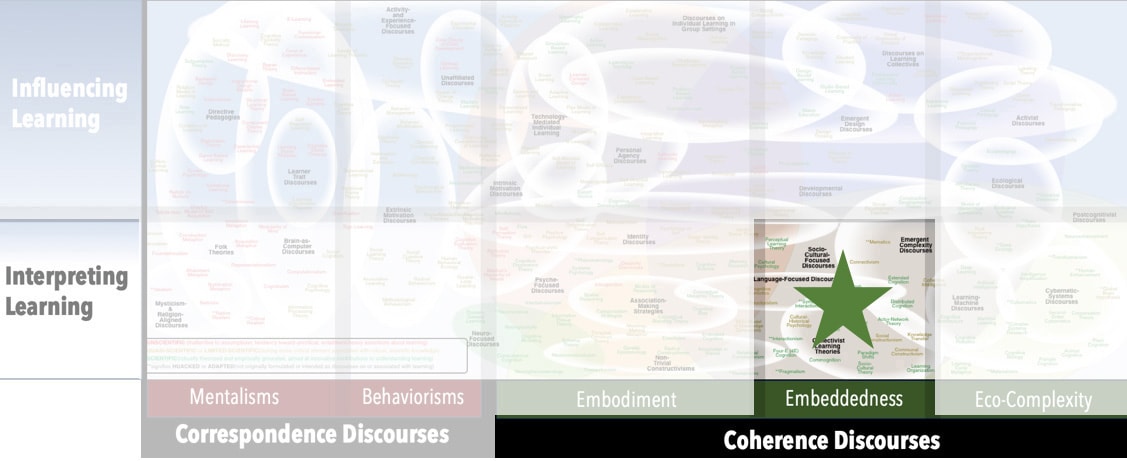Focus
How signs become meaningful and their role in making meaningPrincipal Metaphors
- Knowledge is … scope of interpretive possibility
- Knowing is … using signs
- Learner is … a sign-using system (individual, interpersonal, cultural)
- Learning is … making meaning
- Teaching is … interpreting
Originated
1860sSynopsis
Semiotics is concerned with the role of signs in making meaning. Semiotics assumes that individuals cannot have direct knowledge of things and events, and so a “sign” is ...- Sign – a sort of mediator between one’s mind and an object or event. A Sign is a stand-in that represents something else. Most Signs are arbitrary (i.e., inherently meaningless) and may be icons (images), pointers (that direct attentions), or symbols (e.g., numbers, words, gestures). People usually use combinations of Signs to communicate. A Sign has two main components:
- Signified (Plane of Content) – the form or concept that a Sign refers to, stands for, or represents
- Signifier (Plane of Expression) – experienced (i.e., observable, hearable) aspects of a Sign, such as a word or emblem. Types of Signifiers include:
- Floating Signifier (Empty Signifier; Open Signifier; Sliding Signifier) (Claude Lévi-Strauss, 1970s) – a Signifier with a vague, shifting, and/or unspecified Signified – and so subject to diverse and often-incompatible interpretations
- Iconicity – a reference to the extent of similarity between two forms that enables one to serve as a sign or symbol for the other
- Semiosis (Sign Process) (Charles Sanders Peirce, 1860s) – the triggering of some sort of meaning by a “sign” – which is anything that can trigger a meaning that is not about itself
- Semiology (Ferdinand de Saussure, 1900s) – an umbrella term that reaches across any theory or study of sign processes
- Enclothed Cognition (Hajo Adam, Adam Gakinsky, 2010s) – the hypothesis that what one is wearing is laden with consequential symbolic meaning, based on empirical evidence that one’s clothing affects one’s self-perception
- Biosemiotics (Friedrich Rothschild, 1960s) – a field in which biology is understood in terms of Semiotics. That is, Biosemiotics is a perspective on knowing and communicating that refuses a separation of biological and cultural, whereby sign processes are understood as intrinsic and essential features of life.
- Cybersemiotics (Søren Brier, 1990s) – a blend of Information Theory (see Cybernetics) and Biosemiotics (see above), aimed at an account of knowledge systems, cognition, information, and communication that reaches across the realms of the living, the non-living natural, and the technical
- Ecosemiotics (Winfried Nöth, Kalevi Kull, 1990s) – a blend of Ecological Discourses and Semiotics. Ecosemioticscovers much the same ground as Biosemiotics (see above), but its analyses are more ecosystem-rooted and explicitly attentive to different layers/levels of dynamic, living systems.
- Umwelt Theory (Jakob von Uexküll, Thomas Sebeok, 1930s) – a Semiotic theory that asserts signification and communication, for humans and non-human animals, rest on biological foundations. Associated constructs include:
- Umwelt – in Ethology (see Animal Cognition), the specific, unique way that an organism or species is perceptually coupled to the environment – that is, the biologically conditioned sensory world of an organism or species
- Zoosemiotics (Thomas Sebeok, 1970s) – a branch of Biosemiotics (see above) that is concerned with animal forms of knowing – that is, semiotic processes shared by animals, which includes cross-species communication and signs that are not necessarily communicative (e.g., camouflage)
Commentary
Semiotics interrupts or rejects many commonsense assumptions about knowledge and communication, and so the theory can be very difficult to understand and explain. Consequently, most criticisms seem to be associated with interpretations that are shallow or false. Of the criticisms that are based on careful reading, a common concern is that many theorists seem to refer to individuals’ uses of “signs” in a manner reminiscent of the knowledge-objects of the Acquisition Metaphor. That is, signs are frequently discussed as being acquired, as mental representations, and as internal symbols – suggesting that many proponents of Semiotics actually work from quite unsophisticated theories of learning.Authors and/or Prominent Influences
Charles Sanders Peirce; Ferdinand de Saussure; Mikhail Bakhtin; Roland BarthesStatus as a Theory of Learning
With its focus on how meaning is made, negotiated, and propagated on personal, interpersonal, and cultural levels, Semiotics might be seen as a trans-level theory of learning – that is, one that implicitly casts persons, collectives, and cultures as nested, intertwined learning systems.Status as a Theory of Teaching
Semiotics is not a theory of teaching, and it offer no advice (direct or indirect) on influencing learning. (That said, see Semiotic Pedagogy.)Status as a Scientific Theory
Interpreted as a theory of learning in the manner described above, Semiotics can be classified as a scientific theory. It is critically attentive to its assumptions and constructs, and it is associated with considerable empirical evidence.Subdiscourses:
- Biosemiotics
- Cybersemiotics
- Ecosemiotics
- Enclothed Cognition
- Floating Signifier (Empty Signifier; Open Signifier; Sliding Signifier)
- Iconicity
- Semiology
- Semiosis (Sign Process)
- Sign
- Signified (Plane of Content)
- Signifier (Plane of Expression)
- Umwelt
- Umwelt Theory
- Zoosemiotics
Map Location

Please cite this article as:
Davis, B., & Francis, K. (2024). “Semiotics” in Discourses on Learning in Education. https://learningdiscourses.com.
⇦ Back to Map
⇦ Back to List
